For two days over Easter weekend 2024, Stoneleigh Park hosted the biggest new antiques fair the Midlands has seen for a long time. We went along as traders to try our luck.
Exciting News!
A few months ago a fellow trader mentioned there was to be a new antiques fair at Stoneleigh Park, near Warwick. Any local antiques fair is a cause for excitement but the fact that the organisers were to be IACF made the news doubly so. IACF, in case you’ve not come across them, organise some of, if not, the biggest antiques fairs in the UK. Having them set up almost on our doorstep sounded brilliant.
Awaiting my chance to book
A quick search of the IACF website supplied me with the show dates, but not a booking form. After much digging (and an exchange of emails with the organisers) it seemed that because I’d not booked directly with them before, they wouldn’t take a booking from me until their existing traders had had first pick of whether to stand or not. This of course is fair enough but was a still bit frustrating since I’d stood at Newark Runway last year but only as a day booking. Since IACF no record of me lighting up one of their events I added myself to their email circulation list and settled in for a slightly nervous few weeks until the booking form went public.
Booking was simple enough although what was on offer was a bit vague especially since I’d never been to Stoneleigh Park. The instructions said to pick either Hall 1 or Hall 2 (Hall 1 being slightly cheaper, but with no explanation as to why) and then decide how big a pitch you wanted. We opted for Hall 2 with our usual single pitch and one extra table. This came to a grand total of £207. To give you an idea of costing, that’s probably about 50% more per day than we’ve ever paid before and since this was our first ever two day event the cost felt like a pretty significant outlay.
Looking back, I think we picked Hall 2 simply because we didn’t want to be put in a dark corner and to feel we should have paid a bit extra for better visibility. We reckoned that given the amount of effort involved in being there, we should give ourselves the best chance possible.
We sent off our post-dated cheque and then waited for news. As it turned out the first indication we had been given a pitch was seeing that our cheque had been cashed. It was several days later before our car permit, instructions and map arrived in the post. Looking through the very clear instructions it was clear that Stoneleigh may have been a new venue to IACF but they’d obviously done this sort of thing before (they run about 30 large events a year!).
Planning for the big day
The format of the set up was fairly simple. Thursday afternoon was available for set up from about 1:00 p.m. with the doors to the hall being locked at 6:00 p.m. Saturday was an early start with the doors opening at 06:30 a.m. with trading to start for anyone prepared to pay extra from 07:00 a.m. Sunday we had a late start with the doors opening at 09:00 a.m. On both the public days we finished at 04:30 p.m.
The first instruction for the event was on a label on the back of the envelope – in big, red letters. It instructed traders not to arrive before 06:00 a.m. on Thursday, the set up day. Given that the doors to the halls didn’t open until 1:00 p.m. arriving before 6:00 a.m. seemed a bit enthusiastic but I’m sure IACF know their traders better than I do.
Not quite what we expected
Thursday came around and off we set with a car full of stock. We weren’t in a hurry. We aimed to arrive about 2:00p.m. as we expected to only need a couple of hours to set up. It’s a good thing we weren’t pressed for time.
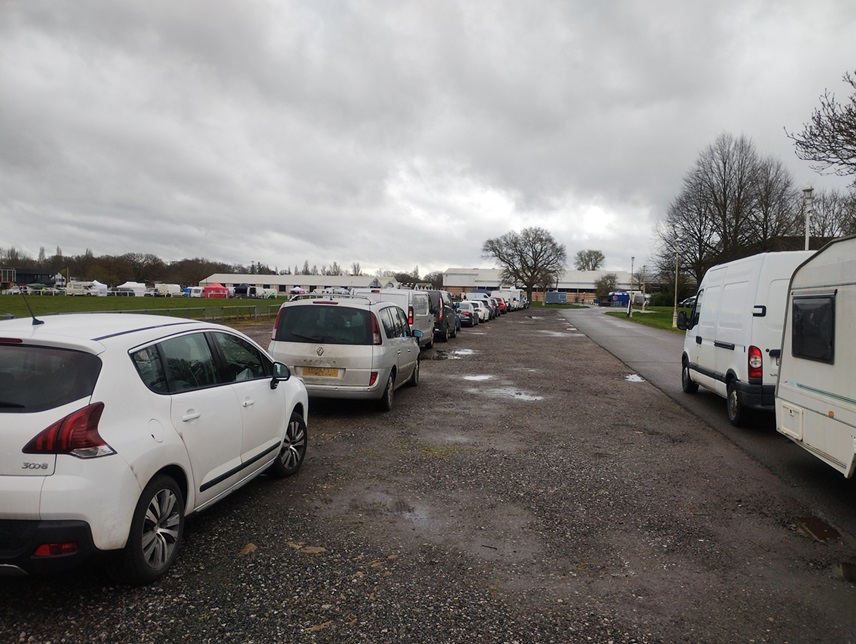
We, along with a few other late comers (it seems many people had been queuing for much of the morning) had to sit for over an hour before being allowed to drive up to unload. Apparently, the plan was that traders would park adjacent to the halls, unload, then move their vehicles away to let others come in. This was never going to happen. Once parked, that was it. The traders unloaded and went inside to get set up.
Given the near biblical deluge that was occurring you can’t blame anyone for not wanting to try to move their vehicles further from the shelter of the hall.
We, along with a few other late comers (it seems many people had been queuing for much of the morning) had to sit for over an hour before being allowed to drive up to unload. Apparently, the plan was that traders would park adjacent to the halls, unload, then move their vehicles away to let others come in. This was never going to happen. Once parked, that was it. The traders unloaded and went inside to get set up. Given the near biblical deluge that was occurring you can’t blame anyone for not wanting to try to move their vehicles further from the shelter of the hall.
I have to say the stewards did a good of keeping people under control but at least one dealer ahead of us in the queue simply gave up and left. Was she turning her back on her £200 pitch fee, I don’t know, but it certainly looked like it? When we finally got called to drive up close, there were spaces to be had at the far end of the parking area all the time we had been waiting. At last, and despite the rain, our setup finally started almost two hours later than we anticipated.
Finally, the set up begins
Having found our pitch we had to ask a steward for an extra table as we’d only been left one. As it turned out, we were adjacent to two unsold pitches which we were later invited to take over. That was really great news but it would have been even more welcome if someone had left us a note before we’d spent over an hour setting up. My guess is that IACF had filled the halls with known traders and then given new traders whatever space was left. This meant we were about as far from entrance as possible, but I doubt we’ll ever have a triple pitch again!
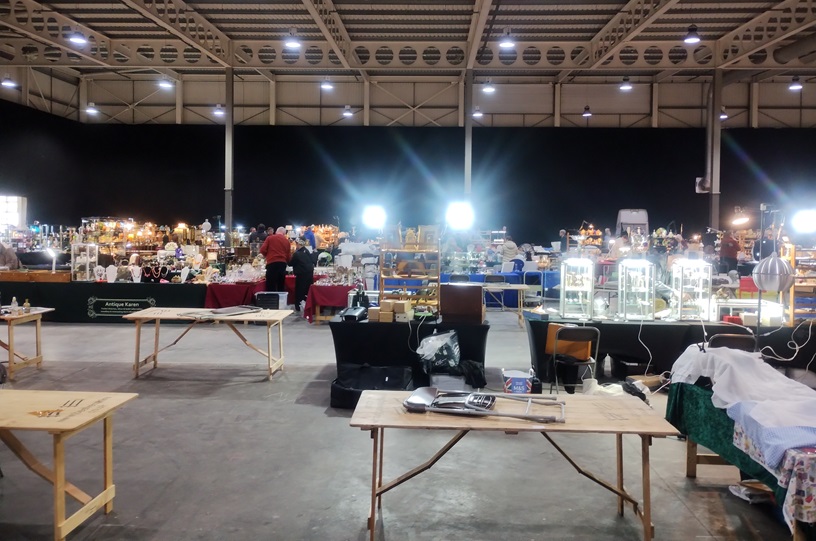
At any show, traders being traders, the buying and selling starts as soon as you start to unpack. It’s not quite the frenzy of a car boot sale where people are standing over you as you open boxes but we still managed to sell several items on Thursday evening. There’s nothing better than selling a few things before the starting gun has been fired. Our spirits rose even more as we realised that five of our friends and fellow traders were in the same hall so there was chance for a good catch up of news and a sharing of excitement before lockup time at 06:00 p.m.
Day 1 – How exciting?
There’s nothing good about a 4:45 a.m. alarm call. Even with the excitement of a two day show ahead of you, getting up at that time always feels wrong. Caffeine and adrenaline can only get you so far. For a Yorkshireman the final push that gets me up is the prospect of making a bit of money.
In truth, I couldn’t complain. The sun was just about getting up and the roads were quiet (and thankfully no more flooded than they had been the evening before) so the 40 minute drive to Stoneleigh was simple and not unpleasant. Knowing you’re already set up makes a huge difference compared to a one day event where you have a mad first hour of parking, unloading and setting up. Parking was simple this time and on the stroke of 06:30, the front doors opened and in we traders trooped.
What to expect
This was really the first time I was able to see clearly the layout of the event. Outside the halls were the “shopping arcades”.
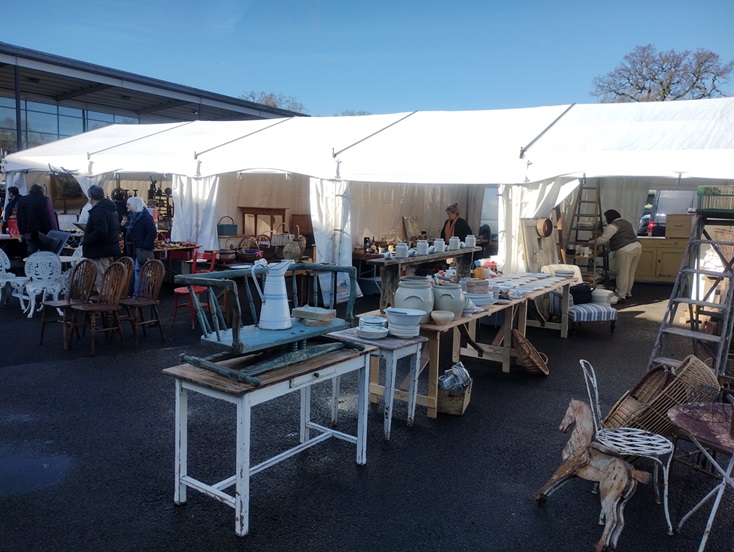
These were formed of tents, each with a long, uncovered entrance way. These were the first thing visitors would see, even before entering the halls. In the absence of rain these would really suit the sellers of larger items, particularly salvage and architectural goods. I can imagine them being really popular with buyers and sellers, not least because collection should be possible for even the largest of things. This year I suspect that the intermittent downpours possibly took the edge off the success but at least buyers would see the arcades first, whilst they were still fresh and enthusiastic.
Hall 1 versus Hall 2 – did we make the correct choice?

On entering the main buildings, visitors walked into Hall 2 first. However, given the time it took buyers to even reach our stall I think a lot turned left and visited Hall 1 first. Understandably for a first event, there was much discussion between the traders on the different merits of the two halls. For what one person’s views are worth, here are my thoughts…
As I mentioned earlier, pitches in Hall 1 were slightly cheaper. I can see no reason why either hall would be more or less expensive for a pitch than the other. Hall 1 has a lower ceiling height and is somewhat smaller. The set up in Hall 1 felt as if it was at full capacity. Maybe a lot of traders knew not to pay more than they had to?
Hall 2 felt as if it could have taken more than the 300 or so stands that had been set up (albeit that a few were not taken). For us, the big benefit of Hall 1 would have been that the roof had some clear panels, allowing in much more natural light. Hall 2 has a sold roof and rather mean lighting. Since we don’t use much artificial lighting, our mainstay of glass and ceramics really didn’t stand out. That’s a problem that we need to address but the poor ambient lighting was something several visitors commented on as they came past.
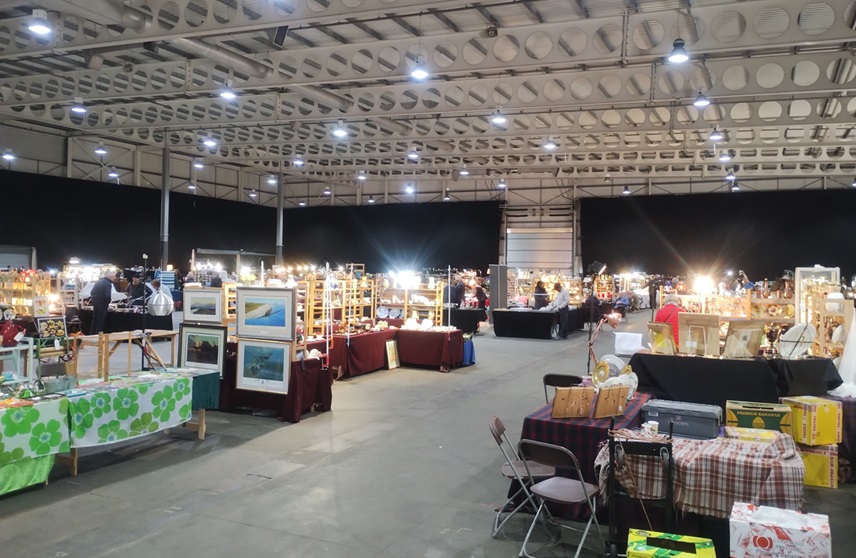
Hall 2 seemed to have wider isles. In a busy show this makes for a more enjoyable experience as a buyer but it was never a problem over the two days of this show. If anything, by the time the buyers reached the area we were in, the arrangement probably felt a bit sparse. Hall 1, being more compact, had more of a buzz, with higher noise level and a greater density of people.
It’s not always about packing people in
There is an ideal density of buyers for fairs and it’s not just “the more the merrier”. You want people to have to come up to your pitch to be able to see it all. Too few people and buyers can just walk past with a glance, potentially missing something they might actually like. Too many people and it becomes a bun fight and buyers can’t concentrate on what’s in front of them.
There’s also the issue of stock safety and security. Things do get stolen, not often, but it happens. Items also get broken, again not often, but it’s always a cause of embarrassment all round when it does. Both are more likely to happen when a fair gets very busy and people are crowding in.
Most people also like a few other people around them when they are browsing. They take more time to look and feel less pressured. Visitors who are less familiar with fairs often feel comfortable when they are the only person looking at a stall. The ideal for a trader is to have one or two people in front of their stall as much as possible, not least because it gives the impression that there’s something of interest to be seen and no one likes to miss out on the good stuff. On occasions I resort to moving round and becoming a browser of my own stuff just to encourage others to join me. It can work surprisingly well!
Day 1 – a solid, if undramatic start
Day one started slowly. The early entrants who had paid extra for the pleasure of being let in at 07:30 certainly had the run of the place for several hours. As far from the entrance as you could get, we had to wait two to three hours before there was any sort of buzz in the place. By lunchtime (real lunchtime, not traders lunchtime – which is any time after about 10:00a.m. when you just start eating lunch because you got up ridiculously early) we had a steady stream of potential buyers. This carried on reasonably well until mid afternoon and in fact we had buyers up until about 4:00 p.m.
Although day one never really felt it got off the ground we were probably happy enough with our sales, especially after we added in the sales from the set up day. We’d managed to sell a couple of very large Poole Pottery chargers that had been to several shows and were quite a challenge to transport. We’ve a new rule – if an item won’t fit in the plastic crates we use, we don’t buy it. How long we stick to that I don’t know but really the cost/benefit for larger items just doesn’t stack up when you’re transporting things in a car rather than a van.
The frustrating thing for us was that, at least numerically, our general items sold much better than the ceramics and glass which we focus on. In recent times we’ve moved much more towards ceramics and glass and simply don’t have much general stock left. Ironically this was in stark contrast to our previous fair at Malvern. There we’d been one of only a handful of ceramics traders in the Avon Hall and so we’d done well from our core items and the general stock had been largely swamped by the offerings on the other stands.
Other traders also seemed to have a mixed day. Two friends of ours seemed to have a brilliant day selling as they put it “something for everyone” rather than specialising in any one area. The folk at the double pitch behind us selling larger more architectural items said they had had a poor day and packed up at the end and didn’t return for day two. I think that was unusual, but by the end of day two I think it was probably something others wished they had done (although it is very much frowned upon by the organisers).
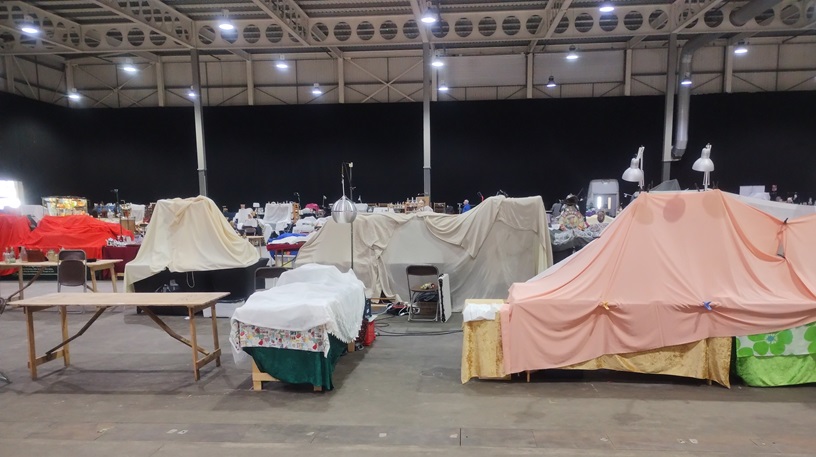
Day 2 – Into the unknown
We were even less sure what to expect of day two than day one. One trader suggested that the profile of the buyers is often very different but with day one being a public holiday I don’t think there was much difference. The only real difference was how few buyers there were.
Overnight, we’d rummaged around in our stock that was probably destined for a car boot sale for other general items we might sell. There wasn’t much but we picked out two items that did sell for quite a bit more than we’d have got at a car boot. Both were things that we’d tried to sell many times and had given up on. It does show you really can’t tell what will sell.
Day two never really got off the ground for us though. It was saved by one dealer spending quite a bit for items he was going to be selling on, so it was more about turnover than profit. Some of the items we’d had for a while, some were very new to us but by that stage it was good to sell anything. By 2:00 p.m. the hall was pretty empty and although, in theory, the event closed at 4:30, I think you’d have been on your own by then.
Early packing up is often a point of contention at shows. Anyone paying to come in with two hours to go on the second day would have every reason to feel cheated as most dealers would have either packed up or would be in the process of doing so. Having said that, it’s a big ask of the traders to stand around for the last hour when almost no one is actually in the hall, especially as many will have a long drive ahead of them. Suffice to say, by 5:00 p.m. we were having a well earned cup of tea at home.
Some final thoughts
So after all that, was it all worth it? In pure financial terms, certainly not. We made a profit but probably only if you gloss over the mileage that we put in and accept you don’t pay yourself for your time. However, we’re not trying to make a living from this and I enjoyed almost all of the experience greatly. The atmosphere between the traders was excellent and we got to meet and chat to several people we didn’t previously know. For traders who have done similar shows for years I think there will be some reticence before booking again.
If you’re reading this and wondering about booking a pitch, I’d suggest that you’ll do better as a general seller than a specialist. I would also try to avoid too much low end items. A number of buyers commented on the poor quality of a lot of what was on offer.
For buyers and visitors I think it was probably an excellent event. They, of course, make or break a fair so it’s to be hoped that those who came along will do so next time. With luck some will tell their friends and they will bring them along too. I think IACF will play a long game with the event and we all hope it will build in time. I’m told Stoneleigh was to replace the now defunct Peterborough fair (the site was sold for housing). From stories of the size of the Peterborough fair, Stoneleigh has a long hill to climb yet.